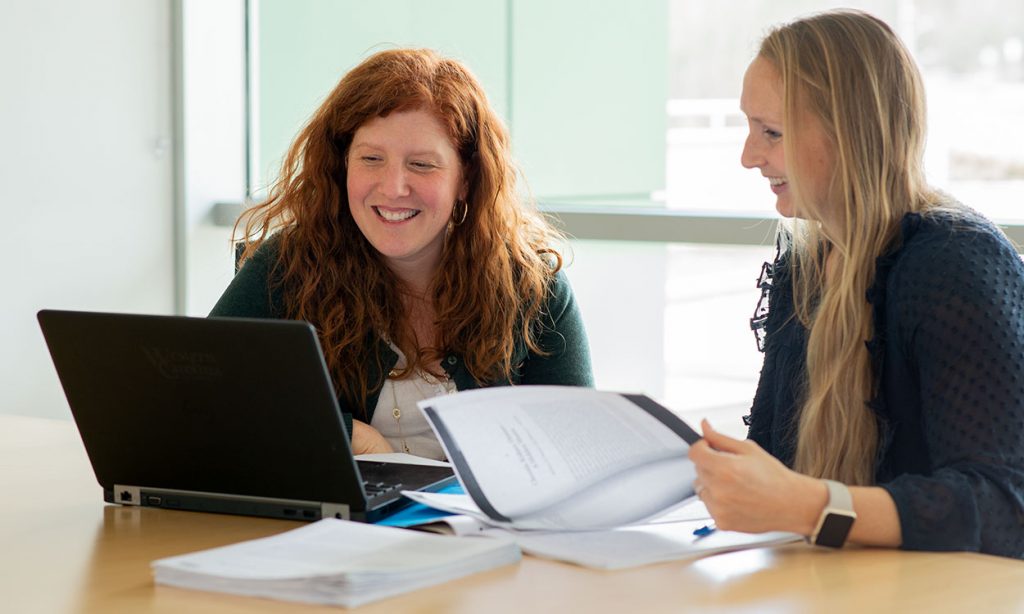Qualla Connection
Unassuming and humble to the point of charming, the log building that is home to Western Carolina University’s Cherokee Center is located at 1594 Acquoni Road, past the tourist attractions of downtown Cherokee and shaded by trees near the junction of U.S. 441.
Founded as an office for outreach and partnership development between WCU and residents of the Qualla Boundary, the Cherokee Center is committed to serving the Eastern Band of Cherokee Indians and the surrounding area with a broad range of assistance for students interested in attending WCU. That aid includes help with the application process, campus tours and educational workshops, as well as work with alumni engagement and cultural awareness.
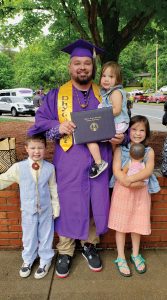
Michael Slee ’19 , seen here in post-commencement celebrations with (from left) son Sean, 4, and daughters Atlas, 2, and Misha, 6, credits the Cherokee Center with helping him return to WCU and obtain a bachelor’s degree.
Of course, an office is merely a physical location; it’s the collective work of staff and the involvement of the community that establishes the crucial link between WCU and the native community, one that has burgeoned into a series of student success stories and endeavors for the future.
One recent success story is Michael Slee ’19, a nontraditional student, enrolled member of the Eastern Band and married father of three who lives in Cherokee’s Birdtown community. His educational experience was anything but routine. An abbreviated university enrollment lasted only one semester, followed by a period that Slee describes as one of immaturity and poor decision making.
“I finally decided to go back to school later in life and obtained an associate of applied science degree in business administration from Southwestern Community College,” he said. With assistance from the Cherokee Center, he was accepted at WCU and began studies in the business administration and law program. “Without the Cherokee Center, I likely would not have been able to transfer back to WCU and graduate from the university that works so closely with my tribe,” Slee said.
OPEN DOORS, HELPING HANDS
The Cherokee Center took its first steps toward reality in 1975, thanks to then-Chief John A. Crowe and newly installed Chancellor H.F. “Cotton” Robinson, who outlined plans for how he wanted the university to more soundly fulfill its regional mission. The program began with dual goals. One was to provide people of the Qualla Boundary with a university experience in a familiar environment. The second was to have an office that could identify needs and provide assistance in a timely manner for members of the Eastern Band.
“The creation of the WCU center was very instrumental in offering sustaining support for Cherokee students,” said Mary Wachacha ’75, a member of the Cherokee Center Advisory Board. “While Cherokee students are just as bright and intelligent as anyone, Cherokees have not traditionally mixed with non-Indians. Around the early 1970s to the mid-1970s, many potential students were uncomfortable and apprehensive about leaving Cherokee — even to go to classes at Cullowhee, a mere 22 miles from Cherokee. Therefore, WCU came to the student.”
The early groundwork of classes offered on the Qualla Boundary and additional support changed the status quo from one or two Cherokee students graduating every four or five years, Wachacha said, to a Cherokee student graduating every year from WCU. “Now, the Cherokees see more than 50 students graduating every year from institutions of higher learning across the country,” she said. “While the educational system of today’s world has changed dramatically, many older Cherokee alumni would have struggled without the ongoing support of the Cherokee Center.”
In 1980 with foundations, figuratively and literally, in place, Robinson told a Charlotte Observer reporter that his “desire was to set about to establish this university as the university for the Cherokees, as well as for the region.”
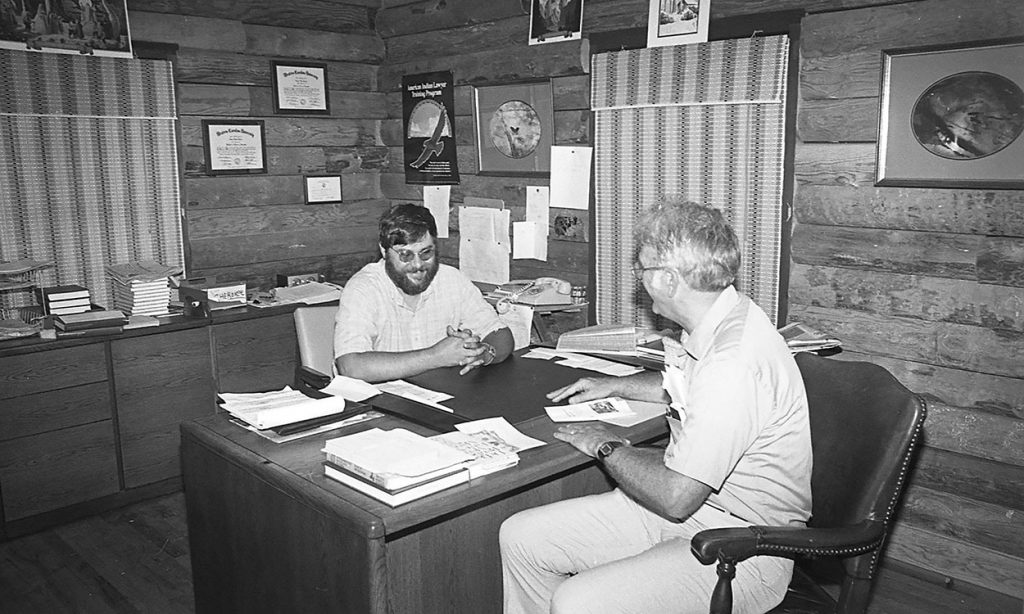
Jim Farris ’79 MAEd ’83 (left) and Larry Arney ’51 , discuss program activities.
The center’s directors — Glenn Bridges ’38 MAEd ’53 and Roy Douthitt MAEd ’75 — guided it through its formative years, while Lawrence Arney ’51, James Farris ’79 MAEd ’83 and Roseanna Belt provided more than three decades of stability in leadership for the center and its programs.
As current director of the Cherokee Center, Sky Sampson ’10 serves as a liaison between WCU and the communities and schools in Cherokee and the surrounding area. Among her many responsibilities is helping to implement a strategic plan, which was developed jointly by the Eastern Band and WCU administrators. How the plan plays out is accomplished with an understanding and consideration of native heritage, mountain culture and 21st-century circumstances.
“Coming through the door at the Cherokee Center is the opportunity to open new doors for the future of our Eastern Band students,” said Sampson, an enrolled member of the Eastern Band. “We have annual events and activities based on Native American and Cherokee heritage and we have increased programs both here and on the Cullowhee campus that engage students and celebrate their potential, their success and their future.”
With a long list of projects in various stages of planning or execution, Sampson has high hopes for a new summer program called “Shadow Cats.” A job shadowing experience, funded by a Cherokee Preservation Foundation grant, it provides opportunities for enrolled tribal member high school students to spend a week with a WCU employee and an additional week on the job with a tribal member.
Another project is Judaculla Camp, an on-campus, weeklong experience designed specifically for Eastern Band rising sophomores, juniors and seniors that was held for the second time this summer. Participants learn about college life and the many career paths offered at WCU. Topics include engineering, Cherokee studies, cultural diversity, archeology and health sciences. Students also meet with current tribal students and alumni, tackle team-building exercises and form a connection to the university. “This is something I’m really excited about,” Sampson said. “The camp is capped at 20 students, with time divided between instructional interaction and physical activity. Like any summer camp, there’s fun while learning, and a lot of staying busy.”
Popularity ensures a continuation of “Catamount Day,” when the Cherokee Center invites native populations from regional high schools to see the variety of activities and curriculum that WCU offers, with plenty of hands-on experiences.
“We specialize in this particular community, though anybody can come in the door. You don’t have to be an enrolled member of the tribe,” said Elias Huskey ’13, center administrative support associate. “We try in many ways to be the university’s liaison with the tribe. We do outreach, advising and it’s an easy place to talk, so we’re a little bit of a club. We’re a tribal resource, especially for first-generation students. We can help on a practical level. People feel comfortable here, talking to us.”
READY RESOURCE ROLE
The Cherokee Center plays a functional role for the Cullowhee campus as well, such as aiding with Cherokee or Native American events, naming of institutional buildings or landmarks, installation of artwork and other activities. In October 2017, Principal Chief Richard Sneed and Chancellor David O. Belcher signed a memorandum of understanding establishing a baseline goal of having at least 50 Eastern Band students enrolled at WCU during any given semester, with a charge to the Cherokee Center to lead those efforts.
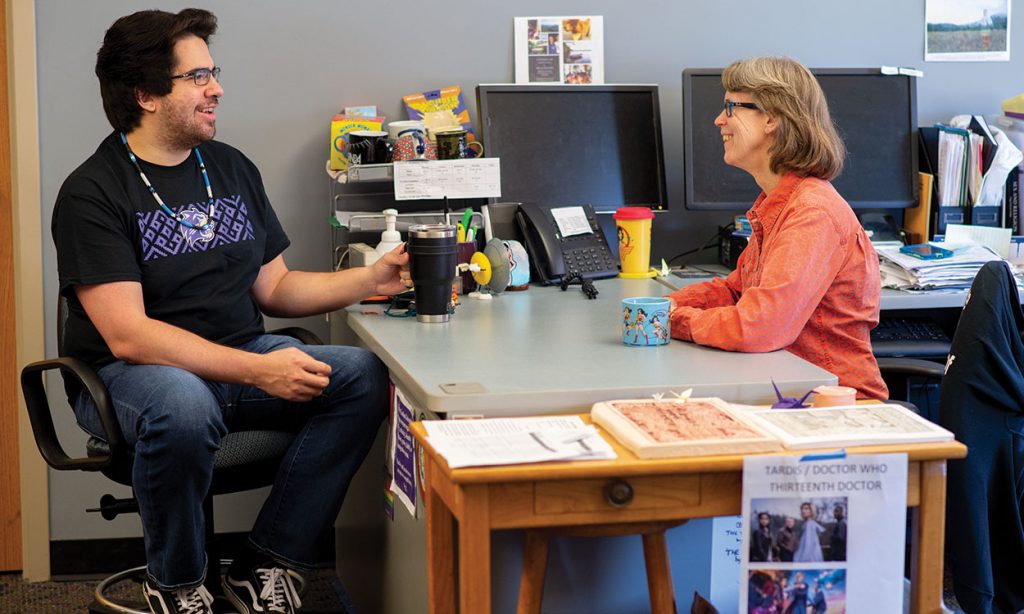
Driver Blythe ’18 speaks with Amy McKenzie of the Department of Philosophy and Religion.
“There are multiple resources the Cherokee Center provides for all students attending any college or university,” said Driver Blythe ’18, an enrolled member of the Eastern Band who was instrumental in re-establishing the student organization Digali’I, which works to foster Native American culture at WCU. “The center is a welcoming environment and is open to the public in case they need help with paperwork, registration, educational opportunities, future events, or really anything that is associated with the university. I have had the opportunity to work with center staff on multiple endeavors and they have helped me with events.”
One common misconception about the center is that just because it is closely associated with WCU, it is open only for Catamount students, Blythe said. The Cherokee Center has helped students from the University of Tennessee, University of North Carolina Asheville, Southwestern Community College, Mars Hill University, UNC Chapel Hill, High Point University, Yale University, Duke University and many more institutions, he said.
Casey Cooper, chief executive officer of Cherokee Indian Hospital and member of the WCU Board of Trustees, described the Cherokee Center as an important conduit between the local community and WCU, one with multifaceted capabilities.
“The center is an accommodating link for education and a means for the region to remain culturally congruent,” Cooper said. “This is a reciprocal means to encourage students to flourish in the classroom and in their careers. An aspect that I’m quite familiar with is WCU’s workforce development, especially for health care needs, like those through WCU’s outstanding School of Nursing.”
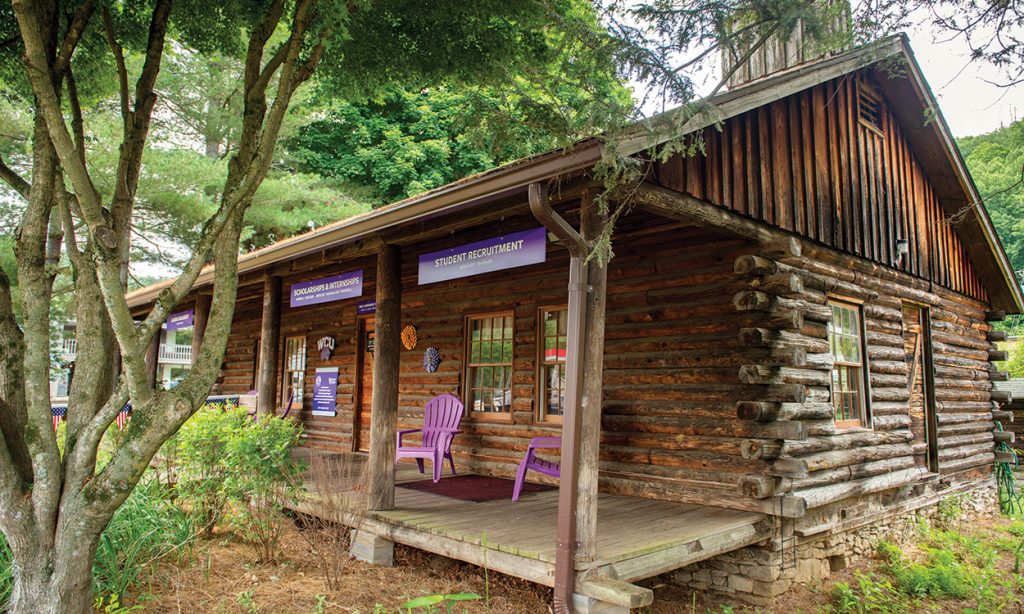 The center does an excellent job of connecting the university to the tribe, and also
in promoting the university and the importance of furthering one’s education to non-native
and native alike, Cooper said. “The Cherokee Center is a valuable resource and an
asset that is constantly developing new ideas that work for this community,” he said.
The center does an excellent job of connecting the university to the tribe, and also
in promoting the university and the importance of furthering one’s education to non-native
and native alike, Cooper said. “The Cherokee Center is a valuable resource and an
asset that is constantly developing new ideas that work for this community,” he said.
The Cherokee Center puts a native finger on the pulse of the Cherokee and college cultures, helping ensure the health and vitality of both, said Phil Cauley ’83 MS ’90, assistant vice chancellor for undergraduate enrollment.
“It plays a role as the conscience and consciousness of learning and understanding so that we don’t repeat mistakes of the past, we celebrate the uniqueness of the present, and we continually construct paths of progress toward a mutually bright future,” Cauley said. “The Cherokee Center is culturally multilingual — translating and interpreting Cherokee culture, customs, tradition, needs and aspirations to WCU on behalf of the Eastern Band and interpreting higher education policies, procedures, protocols and priorities to tribal members on behalf of WCU. The Cherokee Center aids in speaking one another’s cultural language.”
Since its founding, the Cherokee Center has served as a resource for resourcefulness, by educating and empowering tribal members as to the importance and availability of higher education opportunities within the region, especially at WCU, and the nature of availing oneself of those opportunities, said Joyce Dugan ’75 MAEd ’81 a Cherokee Center Advisory Board member, former principal chief of the Eastern Band and the first woman elected to the post.
“The WCU Cherokee Center has proved to be a valuable resource for our members who are interested in pursuing higher education,” said Dugan, a member of WCU’s Board of Trustees. “Based on my own experience many years ago, the main campus appears large and formidable, so having a center that is readily available and easy to access is a real plus for our potential students.”
